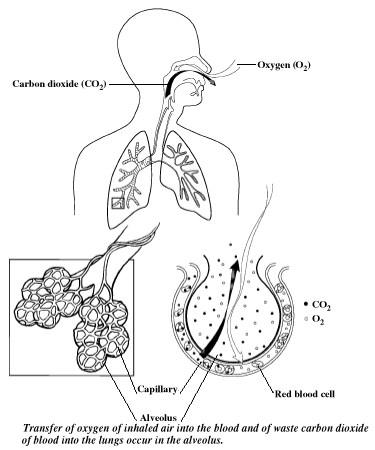How the Lungs Work
The lungs provide a very large surface area (the
size of a football field) for the exchange of oxygen and carbon dioxide between
the body and the environment.
A slice of normal lung looks like a pink sponge
filled with tiny bubbles or holes. These bubbles, surrounded by a fine network
of tiny blood vessels, give the lungs a large surface to exchange oxygen (into
the blood where it is carried throughout the body) and carbon dioxide (out of
the blood). This process is called gas exchange. Healthy lungs do this very
well.
Here is how normal breathing works:
- You breathe in air through your nose and mouth.
The air travels down through your windpipe (trachea) then through large and
small tubes in your lungs called bronchial (BRON-kee-ul) tubes. The larger
tubes are bronchi (BRONK-eye), and the smaller tubes are bronchioles
(BRON-kee-oles). Sometimes the word "airways" is used to refer to the various
tubes or passages that air must travel through from the nose and mouth into the
lungs. The airways in your lungs look something like an upside-down tree with
many branches.
- At the ends of the small bronchial tubes, there
are groups of tiny air sacs called alveoli. The air sacs have very thin walls,
and small blood vessels called capillaries run in the walls. Oxygen passes from
the air sacs into the blood in these small blood vessels. At the same time,
carbon dioxide passes from the blood into the air sacs. Carbon dioxide, a
normal byproduct of the body's metabolism, must be removed.

The airways and air sacs in the lung are normally
elastic—that is, they try to spring back to their original shape after
being stretched or filled with air, just the way a new rubber band or balloon
would. This elastic quality helps retain the normal structure of the lung and
helps to move the air quickly in and out. In COPD, much of the elastic quality
is gone, and the airways and air sacs no longer bounce back to their original
shape. This means that the airways collapse, like a floppy hose, and the air
sacs tend to stay inflated. The floppy airways obstruct the airflow out of the
lungs, leading to an abnormal increase in the lungs' size. In addition, the
airways may become inflamed and thickened, and mucus-producing cells produce
more mucus, further contributing to the difficulty of getting air out of the
lungs. |

